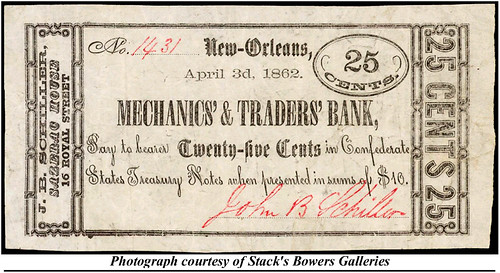
PREV ARTICLE
NEXT ARTICLE
FULL ISSUE
PREV FULL ISSUE
THE J.B. SCHILLER NEW ORLEANS COUNTERSTAMP
As one example of Peter Bertram's thorough work in writing his new book Confederate Numismatica, I'm reproducing here with
permission a section on the J.B. Schiller counterstamp discussed in an earlier E-Sylum article, where it was described as a
"siege token". -Editor

Counterstamped 1860 Indian Head Cent with “J.B.SCHILLER” across obverse, and an ‘X’ on the reverse, suggesting that the coin was intended to pass for ten cents. Considered quite rare as only a dozen or so specimens are presently known. This piece is frequently referred to as a “Siege Token” although I can’t imagine why. At no point in the campaign was New Orleans ever even surrounded, much less under siege! John B. Schiller owned Sazerac House, a saloon at 116 Royal Street in New Orleans. He imported spirits, including Sazerac (a French cognac). Schiller also created a cocktail called the “Sazerac” which helped make New Orleans famous. For many years, including 1860, all the one-cent coins were struck at the Philadelphia Mint. Louisiana passed her Ordinance of Secession on January 26th, 1861, so it seems unlikely that any 1861 cents would have been shipped to New Orleans. With the hoarding of hard coinage brought on by the War, Schiller acquired a quantity of 1860 one cent coins and had them counterstamped to make change at Sazerac House. By early 1862, the coin shortage was so acute that Schiller apparently felt the need to have 25- and 50 cent scrip notes prepared. They were printed on white paper in black ink, dated April 3rd 1862, and signed “John B. Schiller” with a hand written serial number, both in red ink. Note the address typo “16 ROYAL STREET’ rather than “116”. The notes were also backstamped J.B. SCHILLER in red cork. 
When the USS Brooklyn anchored off the mouth of the Mississippi as a blockader, the citizens of New Orleans still felt quite secure behind their city’s defenses which were anchored at Forts Jackson and St. Philip. These two masonry forts were situated some 60 miles below the city at a bend in the Mississippi River. The defenses also included earth-works above the forts and obstructions in the river below, plus a 12 gun-boat river defense fleet and some 10,000 troops in New Orleans under Genl Mansfield Lovell. Over the winter of 1861-1862, Union war planners created the Department of the Gulf with the objectives of capturing Mobile, New Orleans, Baton Rouge, and Galveston. Genl Benjamin Butler was given command of the new Department and planners set the first objective as New Orleans, a major port and one of the South’s largest cities. Union forces began operations against the Crescent City on April 8th, 1862. Admiral DD Porter’s 19 Mortar schooners lead the way up the River, followed by Admiral DG Farragut’s 24 war ships. General Butler followed with some 9,000 troops on transports. On the 17th, under cover of night, the Mortar boats closed on Forts Jackson and St Philip and engaged the old masonry forts from April 18th through the 23rd, firing some 17,000 shells in an effort to destroy the forts’ guns. Despite this massive bombardment, the federals failed to disable the Confederate guns in the forts, but Union gunboats had meanwhile cleared a passage through the downstream obstructions. Admiral Farragut determined to run the gauntlet of the forts with his heavier warships by relying on their greater maneuverability of steam power over sail. Farragut’s heavy fleet ran past Forts Jackson and St Philip at 2:00 in the morning on April 24th. In the darkness a tremendous exchange of fire took place during the passage but the Union fleet got through and continued upstream, where it defeated the Confederate gunboat flotilla. The way to the Crescent City was open. Panic prevailed in New Orleans as citizens fled with their possessions. All the bullion remaining at the New Orleans Mint and millions in bank funds were shipped out of the city to avoid theft by the Federals. Gen Lovell and his troops evacuated the city as 15,000 cotton bales burned on the levee, consuming several dozen ships in the process. Admiral Farragut approached with nine of his large warships and demanded the city’s surrender under threat of bombardment. So New Orleans surrendered to avoid destruction and Genl Butler arrived on May 1st, landed his troops, and took formal possession of the city. But civilian life somehow goes on and Schiller’s Sazerac House continued in business. On May 16th, 1862, occupation authorities put Butler’s General Order No. 29 into effect, forcing the city and all banks to cease any and all trading in Confederate Notes and in any obligations payable in Confederate Notes. The effect was to render Schiller’s scrip totally worthless, so it seems that his notes only circulated for some six or seven weeks. But the business continued to prosper and Schiller sold Sazerac House to his chief clerk in 1870. Sometime after the War, a relative of Schiller’s moved to Canada, taking with him one of the counterstamped coins and one of the 25 cent scrip notes. That coin and note were acquired by a Canadian collector in 1956 who sold them to the Federal Coin Exchange in Cleveland, Ohio. Federal then offered them at auction and they were acquired by noted numismatic scholar Robert J. Lindesmith, who announced their appearance in the TAMS journal (Jan-Mar 1963). Russell Rulau next penned an article about them in Coin World (Feb 1, 1963) and Bill Manning published a short piece in the TAMS Journal (Feb 1978). To read the earlier E-Sylum articles, see:
Wayne Homren, Editor The Numismatic Bibliomania Society is a non-profit organization promoting numismatic literature. See our web site at coinbooks.org. To submit items for publication in The E-Sylum, write to the Editor at this address: whomren@gmail.com To subscribe go to: https://my.binhost.com/lists/listinfo/esylum All Rights Reserved. NBS Home Page Contact the NBS webmaster 
|